Oxford University Press's Blog, page 381
April 10, 2017
Should international law reflect the values of international community?
When international law reflects the values of the international community in a wide sense, it can potentially have a trans-formative effect for international relations and contribute to revising situations of hegemony and domination. If interpreted in a narrow and formal way, the notion of the international community encompasses the specific diplomatic circles, international organizations and international legal institutions in which the elite of practitioners of international law acts and produces international legal norms. Broadening this important notion in order to incorporate the wider community of scholars, public and popular debates about global justice and the denunciation of conditions of inequality, privilege and injustice, appears to be a pending task for the reconfiguration of the mechanisms that govern the production of international justice in world politics.
In the context of recent renovated explorations about the historical connections between imperialism and international law, historians and theorists in the field have become more aware of the limits of international law to transform the structures of international politics and the importance of historicizing and politicizing international law. At the same time, the inclusion of different legal traditions into the values of the international community, including, for instance, the rights of indigenous communities, is a crucial condition for the historical transformation of the international system and the public legitimization of robust principles and practices of international justice. When the inclusive construction of legal pluralism is combined with the practical legitimization of the principles of sovereign equality and multilateral-ism, a skeptical and critical historical sensibility towards international justice could emerge, so the construction of global justice begins to be conceived as not simply a normative ideal, but a subject of historical investigation and a terrain for identifying, denouncing and repairing the wrong by producing empirical critique hand by hand with concrete and practical legal innovation.
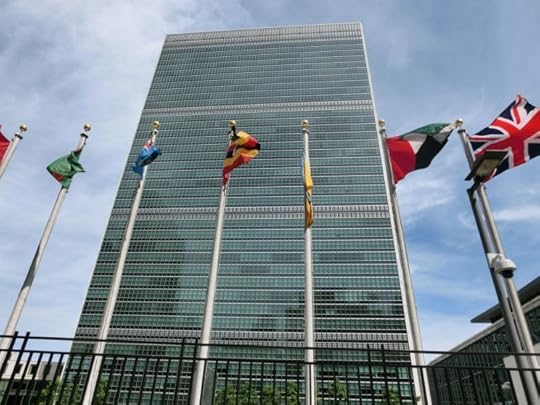 “UN Building” by jensjunge. CC0Public domain via Pixabay.
“UN Building” by jensjunge. CC0Public domain via Pixabay.Although global justice is at the core of current academic and practical debates in the fields of international law and international relations, jurists and international relations specialists do not tend to speak to each other. Yet there are a number of overlapping concerns and preoccupations that could be addressed more insightfully if international power politics and global justice are explored as mutually inter-connected fields. Therefore, international lawyers and scholars in the fields of international law and international relations should not be regarded as formal players involved in the production and deliberation that takes place in the routines, corridors, courses and discussions involving international organizations and international legal institutions.
Instead, they could potentially perform a reflexive and transformative role by contributing to connect world politics with legal debates, formal procedures with public deliberations, professors with students, elitist institutions with popular concerns, and academia with the world of practitioners. As such, they should play a central role creating and shaping debates in the public sphere beyond the elitist community of international lawyers and diplomacy, in order to strengthen the values of legal pluralism, unravel situations of hegemony, and make of global justice, in the context of a hierarchical international system, a subject of public deliberation, popular interest and critical importance for world politics.
Featured image credit: “Flags Blow Colorful” by Hans. CC0 Public Domain via Pixabay.
The post Should international law reflect the values of international community? appeared first on OUPblog.

April 9, 2017
The sound of the Steel City: Orwell, Attercliffe, and the afterlife
There are some sounds in life that simply cannot be put into words. One of them is the sound I heard this morning as I ran along the canal in that very special part of Sheffield known as Attercliffe. The sound shook me to my soul and reminded me of George Orwell’s visit to the city in 1936 when he had been shocked by the realities of hard industrial life. For me, however, it was a glorious sound – the heartbeat of the Steel City.
My son, Charlie, is nearly 18 and is named after his paternal grandfather who worked in the railway sheds in Doncaster. My son is a tall and strapping young chap; a rugby player (union, never league) who those that don’t know him might describe as ‘hard’. Never happy at school he rejected the pressure to follow the prescribed educational routes – which force so many square pegs into round holes – and found a job in a factory in Attercliffe. It’s a tough manual job making pipework for the mining industry. Lunchtime signals a quick trip to ‘Big Baps’ (a sandwich stop not a brothel), a laugh with the lads and then back to the monotony of repetitive tough labour. The day probably ends with a curious glance towards ‘Sauce’ (a brothel not a sandwich shop) while waiting for the first of the two buses that will carry him home across the city.
Friday, however, is a special day. It’s the day that tradition dictates that work starts early and finishes early to allow a good run into the weekend, and it was this tradition that led me to take my early morning run in Attercliffe and to hear the industrial heartbeat. Never has a living, roaring pulse nearly blown me off my feet. The foundry hammer, possibly weighing several hundred tons, smashes raw steel into shape. It’s so crude, so beautiful…so loud. And yet the meaning of any sound depends very much on the context in which it is heard and this demands that the reader knows just a little about Attercliffe. What words might capture this area of Sheffield?
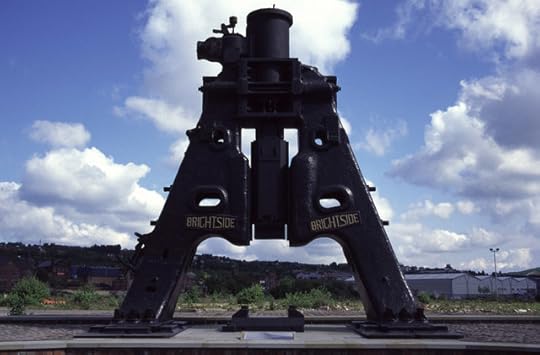 Steam Hammer, Savile Street East, Sheffield by Chris Allen. CC-BY-SA-2.0 via Wikimedia Commons.
Steam Hammer, Savile Street East, Sheffield by Chris Allen. CC-BY-SA-2.0 via Wikimedia Commons.A cruel answer might suggest ‘rough’, ‘grubby’, ‘deprived’ or ‘depraved’; a kinder answer might proffer terms such as ‘exotic’,’ eclectic’, ‘bohemian’ or ‘colourful.’ This is – if we are honest – the area where brothels co-exist with bakeries, and snooker halls with snake shops…it is the old industrial heart of this city – part of the East End of the city that so shocked Orwell when he visited eighty years ago. ‘It seems to me, by daylight, one of the most appalling places I have ever seen’ Orwell wrote in The Road to Wigan Pier, ‘In whichever direction you look you see the same landscape of monstrous chimneys pouring forth smoke which is sometimes black and sometimes of a rosy tint said to be due to sulphur.’
The landscape remains monstrous. The steel mills remain like cavernous caves but are now surrounded by warehouses, scrap metal dealers, scaffolding yards, and every kind of tough trade known to man (or woman). Running along the river provides a glimpse into an industrial past and an industrial present that seems to exist almost as a partially hidden, largely unseen afterlife. This is a landscape that Orwell would certainly recognize – the stone walls blackened by smoke, the rubbish-strewn river banks and graffiti-thick walls – but it is also one that has changed. The ‘shallow river yellow with chemicals’ remains shallow but no longer yellow. Chub, Dace, Gudgeon, and Perch now rest in its clear watery glides. The thick surface scum that used to dry hard in the summer (forming a temporary bridge for local kids to dare each other to run across) is a thing of the past. The smell has been replaced by…smiles.
Have I gone too far? Over-romanticizing the present through vulgar comparisons with the past?
Let me explain. As I ran along the river this morning not one soul – young or old, man or woman, worker or wanderer – passed me by without a quick smile that recognized my existence. Compare this with the streets of London that I scurry along each week; the world where eyes never meet; existence never acknowledged; or, if so, with a defensive stare or scowl. Travel on the underground with its physical intensity of strangers rammed together – cheek-by-jowl, armpit-in-face – nudging and pushing as they jockey for space in an environment devoid of humanity. Orwell may have thought that Sheffield could ‘justly claim to be called the ugliest town in the Old World’ but I’d choose its smiles and sounds, its blend of both the New World and the Old World, above the scowls of London every day of the week.
Featured image credit: Attercliffe – Burton Weir and Norfolk Bridge by Dave Bevis. CC-BY-2.0 via Wikimedia Commons.
The post The sound of the Steel City: Orwell, Attercliffe, and the afterlife appeared first on OUPblog.

In search of a “good” Anthropocene? Physiology can help
It is generally accepted that the Earth has been irreversibly altered by an ever-growing human population. Indeed, we now refer to our current geologic period as the Anthropocene, to stress the great anthropogenic pressure on the planet’s atmosphere, geology, and biological diversity. In the face of threats such as habitat loss, pollution, and urban and agricultural expansion, it is easy to feel discouraged about the future prospect of the world’s ecosystems and biodiversity. However, scientists and conservationists have a choice about how to approach their mission to preserve existing habitats and rehabilitate those already in a state of degradation.
While much of the rhetoric surrounding the Anthropocene has been markedly negative, there has recently been a push by many scientists for a more positive narrative. Specifically, researchers are posing the question: can the Anthropocene be good? A good Anthropocene would balance the preservation of the natural world with realistic societal needs and consumption.
Recent research supports the value of a hopeful, rather than “doom and gloom”, perspective for rallying individuals to action. Messages of optimism are thought to be necessary to broadly engage the public and to attract youth to professional careers in the field of conservation biology. This makes intuitive sense—if experts are constantly heard saying that all is lost, it is difficult to expect anyone to be motivated to change their behaviour.
The field of conservation biology is made up of a diversity of scientists and practitioners that use tools such as genetics, physiology, modelling, demographics, psychology, and social science. All of these branches have the capacity to contribute positive and progressive approaches to conservation science. Conservation physiology, one of the more recent, formally conceptualized sub-disciplines, is actively contributing to and proposing avenues for the good Anthropocene movement. Specifically, these pathways focus on taking a proactive approach to conservation, encouraging a pragmatic perspective when approaching conservation dilemmas, establishing an appreciation for environmental resilience, and being active in public outreach and policy-building. Establishing these four avenues as goals will allow conservation professionals to solve conservation problems through evidence-based conservation, better-populated models, an appreciation of the mechanisms underlying population declines, cross-disciplinary collaboration, and a well-informed public.
 Orange clownfish (Amphiprion percula). Amphiprion percula 3d by Grifon2011. CC BY-SA 3.0 via Wikimedia Commons.
Orange clownfish (Amphiprion percula). Amphiprion percula 3d by Grifon2011. CC BY-SA 3.0 via Wikimedia Commons.One example of how this multi-faceted approach can tackle a large-scale conservation problem is well-illustrated by research on clownfish (Amphiprion percula) in the Great Barrier Reef. Firstly, conservation physiology researchers are contributing to proactive conservation by applying knowledge of the respiratory physiology and microbiome of the fish to plan coastal development, determine vulnerability, predict how sediments from dredging may influence populations, and assess the potential for acclimation. The work is also underpinned by pragmatism. There is an appreciation that development is continuing and tactics are needed to diminish the associated impacts as much as possible. By taking an experimental approach aimed at determining threshold levels of suspended sediments that alter fish assemblage patterns, the timing of dredging can be sensitively adjusted to avoid interference with coral and reef fish spawning. As much of the work focuses on establishing thresholds, it also incorporates an appreciation of resilience and aims to determine when the capacity to cope with environmental change may be surpassed. Finally, researchers also made outreach a priority and took advantage of the public’s familiarity with clownfish in Disney’s Finding Nemo to garner attention about the impacts of habitat alteration on the respiratory health of these native fishes. As a whole, this physiological work has been contributing to evidence-based conservation and restoration plans that help to achieve a better Anthropocene.
Individuals trying to shine a positive light on the Anthropocene believe that leveraging technologies, knowledge, and passionate individuals can accomplish the tasks necessary to maintain nature in perpetuity. As we continue to develop new research foci, attempt to attract new students to our fields, and dedicate ourselves to the preservation of nature, we will do well to remember that “conservation is ultimately an act of hope”.
Featured image credit: Great Barrier Reef Marine Park. Great barrier reef by Wise Hok Wai Lum. CC BY-SA 4.0 via Wikimedia Commons.
The post In search of a “good” Anthropocene? Physiology can help appeared first on OUPblog.

How football fans, political leaders, and religious cues can change minds on LGBT rights
Less than 15 years ago, it was impossible for a same-sex couple to get married, and the public was strongly opposed to the idea. But in a remarkably short period of time, public opinion shifted, as did public policy—first in Massachusetts in 2004, and in an increasing number of states over time, until the US Supreme Court’s Obergefell decision in 2015 which legalized same-sex marriage across the country.
This just isn’t normal. As Ezra Klein has noted, change doesn’t usually come this fast. Public opinion is sticky and people tend to reject information that they disagree with rather than updating their opinions.
What happened?
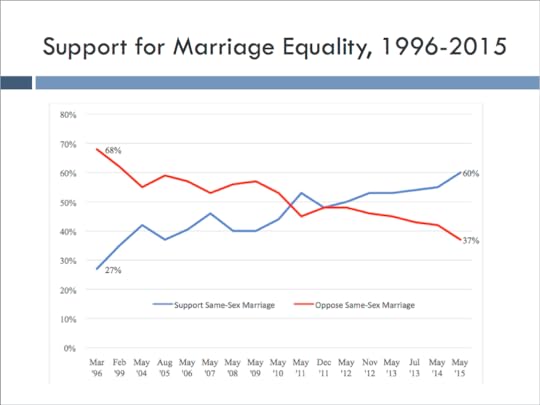 Support for Marriage equality by Brian F. Harrison and Melissa R. Michelson. Used with Permission.
Support for Marriage equality by Brian F. Harrison and Melissa R. Michelson. Used with Permission.There’s not just one explanation. Some of the shift is attributable to cohort replacement (older folks in the population being replaced by younger, more progressive folks), and some to increased exposure to gay and lesbian people in media and in our personal lives. More than one notable public figure has announced a change of heart on the issue of same-sex marriage after finding out that their beloved son or daughter was gay.
But there’s more going on. It’s not just people finding out that they know and love someone who is a member of the lesbian, gay, bisexual, and transgender (LGBT) community. It’s people finding out that those with whom they share another in-group identity are supporters of LGBT rights.
For example, when President Barack Obama shifted his public position on same-sex marriage in 2012, there were overnight increases in Black public support for the issue—the public was taking a cue from a respected leader of their in-group.
We conducted a series of 14 randomized experiments from 2011 to 2014 to test the power of in-group priming to change attitudes toward LGBT rights. We found that just a simple surprising in-group message was often enough to generate substantial shifts in public opinion.
For example, we exposed folks in Appleton, Wisconsin to a supportive statement either from Green Bay Packers Hall-of-Famer LeRoy Butler, or to entertainer Jay-Z. For non-Packers fans, it didn’t matter which statement they read because no in-group identity was primed. For Packers fans, however, exposure to the Butler statement generated a large boost in support for same-sex marriage.
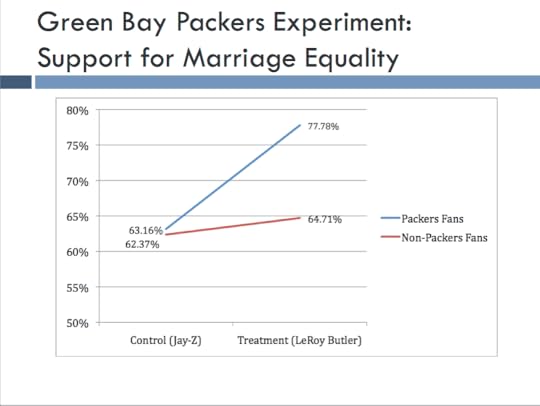 Green Bay Packer Experiment by Brian F. Harrison and Melissa R. Michelson. Used with Permission.
Green Bay Packer Experiment by Brian F. Harrison and Melissa R. Michelson. Used with Permission.We primed sports fan identities, Black and Latino ethnoracial identities, religious identities, and partisan identities. Most of the time, the experiment worked. African Americans were influenced by hearing that the Black president of the United States is a supporter. Religious individuals were influenced by hearing that a religious leader is a supporter. And strong partisans were influenced by hearing that a leader of their party is a supporter.
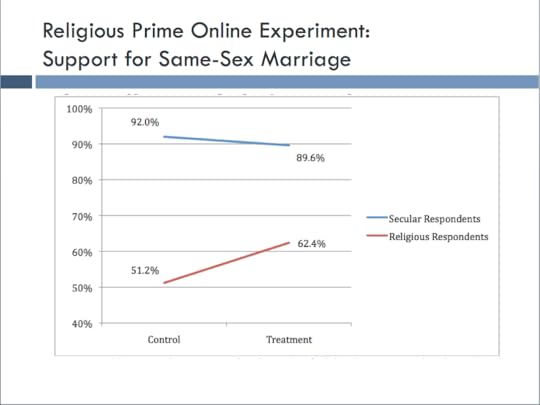 Religious Prime online experiment by Brian F. Harrison and Melissa R. Michelson. Used with Permission.
Religious Prime online experiment by Brian F. Harrison and Melissa R. Michelson. Used with Permission.Our experiments were conducted all over the United States, from San Francisco to Baton Rouge, Louisiana, from Hackensack, New Jersey to Edinburg, Texas. Many were conducted in partnership with LGBT advocacy organizations. We also varied the mode of the experiment, including face-to-face experiments like the Packers experiment, randomized telephone survey experiments, and online experiments.
Yes, your parents taught you to not talk about politics (or religion) in polite company. We respectfully disagree. Speaking out can change minds and can help ensure that everyone can enjoy equal rights. In this political climate, we can’t afford to worry about politeness.
It’s more important than ever to reach out to people and engage them in respectful dialogue about important social and political issues. It can be easy as saying, “Listen, we need to talk.”
Featured image credit: City Hall by Tom Hilton. CC-BY-2.0 via Flickr.
The post How football fans, political leaders, and religious cues can change minds on LGBT rights appeared first on OUPblog.

Why the best teacher of war is war
Although experts often highlight history’s military geniuses, these notable commanders are—by definition—outliers. Despite their successes, the majority of military officers will not join the ranks of Alexander, Caesar, and Frederick the Great.
How then can today’s officers become effective leaders? Historian Martin van Creveld reasons that, similarly to playing an instrument, military officers need to practice war in order to understand how to successfully command and strategize in the line of duty.
In this excerpt from More on War, van Creveld discusses the significant role of experience in military education.
Waging war and fighting it are practical activities much like playing an instrument or, at the higher levels, conducting an orchestra. Hence one of the best, perhaps the best if not the only, ways to familiarize oneself with it is to practice it. As the saying goes, the best teacher of war is war. Other things being equal, the larger and more complex the “orchestra,” the greater the role of the conductor, i.e. the commander. It is he who is ultimately responsible for coordinating the efforts of everybody else and directing them towards the objective. All the while taking care that the enemy will not interfere with his plans and demolish them.
Commanders must start by mastering their job at the lowest level. As the ancient historian Plutarch wrote of the Roman general Titus Flamininu, by serving as a soldier he learnt how to command soldiers. Next, commanders must proceed from one rung to the next until the most competent among them reach the highest level of all. With each additional step additional factors will enter the picture and start playing an increasingly important role. The higher placed a commander, the more varied the kinds of weapons, equipment, and units he will normally be trying to coordinate and use.
Some of the factors are military. Many others are political, economic, social, cultural, and religious. All must be studied, grasped, mastered, and coordinated with all the rest. Such is the nature of war that, at the top, there is hardly any aspect of human behavior, individual and collective, which does not impinge on its conduct. And which, as a result, those in charge do not have to take into account and act upon.
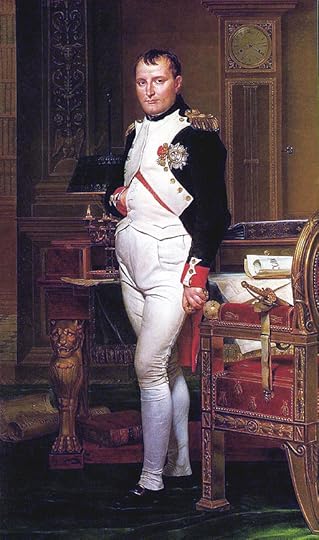 “The Emperor Napoleon in His Study at the Tuileries” by Jacques-Louis David. Public Domain via Wikimedia Commons.
“The Emperor Napoleon in His Study at the Tuileries” by Jacques-Louis David. Public Domain via Wikimedia Commons. Throughout history some commanders reached their positions and exercised their craft almost purely by virtue of practice combined with their own genius. Take André, the field marshal of whom Napoleon said that he was “the greatest name of my military Empire.” Massena was the son of a semi-literate peasant. He served as a sergeant and then spent two years as a smuggler before re-enlisting. He went all the way to the top—without, however, ever entering a military academy. Erwin Rommel, one of the best-known German generals of World War II, did not attend the General Staff College or Kriegsakademie either.
Another example was Ariel Sharon, probably the most gifted operational commander the Israel Defense Force ever produced. Sharon started off as a twenty-year-old private who, in darkness and pouring rain, defended his home village near Tel Aviv against the invading Iraqis. No sooner did he demonstrate his exceptional abilities than, skipping officer school, he was put in charge of others.
Yet neither experience nor genius suffice. Rarely will the experience of any single person cover all the factors with which, assuming positions of greater and greater responsibility, he must cope. As King Frederick the Great of Prussia is supposed to have said, had experience been enough then the best commander should have been the mule that the Austrian commander Prince Eugene of Savoy rode on campaign. Worse still, experience can make those who have it impervious to change. The faster things change, the greater the danger.
Geniuses, by definition, are few and far between. Since one cannot predict or command their appearance in history, they are also unreliable. Stalin, at one dark moment in World War II, is supposed to have said, “We do not have a steady supply of Hindenburgs.”
Whether or not Hindenburg was a genius is not at issue here. What is at issue is that, since most of those destined for high command and desirous of exercising it are not geniuses, they will have to do as best they can by relying on study and education instead. As Clausewitz says, from knowledge to capability is a great step. From ignorance to proficiency, a greater one still.
The future is unknown and unknowable. To assume it will be like the past is dangerous—nowhere more so than in war. Nevertheless, study and education can only be based on past experience. Preferably that of others, for in war any lessons learnt must often be paid for with blood. Experience, properly researched, properly organized, and clearly presented is known as history. Of military history Napoleon once said that any aspiring commander should “peruse again and again the campaigns of Alexander, Hannibal, Caesar, Gustavus Adolphus, (the French commander) Turenne, Eugene, and Frederick the Great.”
Featured image credit: “Line of Soldiers Walkin,” CCO Public Domain via Pexels.
The post Why the best teacher of war is war appeared first on OUPblog.

Philosopher of the month: John Stuart Mill [timeline]
This April, the OUP Philosophy team honors John Stuart Mill (1806-1873) as their Philosopher of the Month. Among the most important philosophers, economists, and intellectual figures of the nineteenth century, today Mill is considered a founding father of liberal thought. A prolific author, Mill’s collected works encompass thirty-three volumes ranging in subject from philosophy to social issues and beyond.
Born in London and educated by his father James Mill, an economist and prominent member of a utilitarian group called the Philosophic Radicals, John Stuart was raised in the intellectual tradition of his godfather, utilitarian philosopher Jeremy Bentham. Mill’s Principles of Political Economy, which promoted the concept of free enterprise while maintaining an awareness of the market’s failure to maximize utility, was the leading textbook in the field for over 40 years. Mill’s On Liberty bases individual freedom on utilitarian values rather than natural right, arguing that the only limit to and individual’s freedom of choice should be when those choices would harm others; it remains among the most celebrated texts on the subject. In his revision of Benthamism, Utilitarianism, Mill argues for a distinction between high and low pleasures, affirming an ethical duty to promote happiness. His System of Logic, Ratiocinative and Deductive provided what some consider to be the most significant contribution to social science methodology prior to the work of Emile Durkheim. Mill served as a member of parliament from 1865 to 1868, where he argued in support of such radical positions as women’s suffrage and Irish land reform.
For more on Mill’s life and work, browse our interactive timeline below.
Featured image: English School, 19th Century, Snow Hill, Holburn, London. Public domain via Wikimedia Commons.
The post Philosopher of the month: John Stuart Mill [timeline] appeared first on OUPblog.

April 8, 2017
Let me tell you a story
Every year, I teach Medical Neurobiology to a new class of medical students. I introduce myself and immediately tell the class, “I am not a physician. I do not have a MD. I have a PhD. But, I am a patient, just as you are, and just like the people you will serve when you are physicians.”
For those of you unfamiliar with medical education in North America, a student in the first two years of medical school learns lots of classroom knowledge but does not actually go on the wards to take care of people. Therefore, these students are still more patient than physician.
The one thing that I do for the students that I am most proud of is to keep them grounded in the patient experience – remember I am no more and no less than a highly knowledgeable patient. I want my students to be responsive, caring physicians that serve their patients. I want to be that teacher that inspires them to treat not only the pathology but the impact of that pathology on a person’s life. I communicate the patient experience by telling stories.
Stories are an important way to keep physicians-in-training in touch with the patient’s perspective. I can tell stories of my own illnesses that involved the nervous system. One that I often tell is a close encounter that I had with confusion or disorientation. I had just flown home from Europe the day after I had shared a room with a snorer whose metronomic snores I was compelled to track through the night. I think I was continuously awake for about 40 hours. I arrived back home and immediately got into bed. I instantly fell deeply asleep, only to be awakened by a ringing phone. I picked up the phone and a voice said hello and asked, “Is Gisèle [my spouse] there?” My mind was a blank. Hmmm, I thought, “that is a very good question.” At that moment, I had no idea who Gisèle was. Nonetheless, I wanted to be helpful to this friendly voice and so I patted the bed beside me to see if any person was there. I then reported, “No, no one seems to be here.” The caller was my sister-in-law who eventually found Gisèle, who was indeed on a trip. My sister-in-law told Gisèle, “I think Peggy is taking heroin or something.” Of course, this is now something to chuckle over but I truly value the experience. It brought me a first-person understanding of how it feels to be confused. Then it went away. Insight without lasting repercussions. All good.
 Doctors, medical students visit USNH Okinawa by Lance Cpl. Natalie Rostran. Public domain via Wikimedia Commons.
Doctors, medical students visit USNH Okinawa by Lance Cpl. Natalie Rostran. Public domain via Wikimedia Commons.Luckily I have had few illnesses in my life and so I depend mostly on the stories of other people. I talk to people – friends, family, students, acquaintances, and complete strangers. Once I was in line at the airport and the woman in front of me had a cochlear implant. I could see it peeking out from her straight brown hair. Then I watched as a TSA agent talked to her without facing her. She didn’t know she was being talked to and the TSA agent began to get agitated, thinking the woman was ignoring him. I tapped her on the shoulder and told her that the TSA agent was talking to her. Afterwards, she and I had a pleasant ten-minute conversation about her hearing loss and ultimate decision to get a cochlear implant.
I listen in rapt attention to people’s stories, uttering only occasional prods when I sense the narrative slowing or the narrator tiring. I want to know all the details. How did you figure out something was wrong? “I fell.” “My daughter insisted I go to the doctor.” How quickly did you get a diagnosis? Sadly, the answer to this is often way too long, months or years. What did having a diagnosis mean to you? I have not talked to anyone who was not glad to leave limbo behind and have a diagnosis, even if they hated the implications of the diagnosis. How would you rate your illness on a scale of one to ten, with one being a curse and ten a growth experience? One of my friends rated his Parkinson’s as an eight or nine. Why? Because it brought him closer to his wife and made him more compassionate and ultimately, he felt, a better person. I believe that it is just as important that a medical student understand the wide range of human reactions to illness as that they understand the pathophysiology of any given disease.
My interest extends to the family members and friends of people with a misbehaving nervous system. I was once at a party and while people clinked glasses and chatted about their gardens and vacations, I talked to a man about his mother’s diagnosis with amyotrophic lateral sclerosis. I used all of my body language to keep others from joining our conversation; I didn’t want them to interrupt this intimate and invaluable conversation. I was successful and I heard how much he valued his mother’s diagnosis, devastating as it was at the same time. Before the diagnosis, everything was confusion and uncertainty. Afterwards, he said, “I knew what we were dealing with and I knew approximately how long we had. That enabled me to arrange my life to make the most out of what time remained.”
These stories have provided me with great insight to the patient experience and I hope that they stay with you as they have with me.
Featured image credit: Progress Clinical Medical by sasint. CC0 Public Domain via Pixabay.
The post Let me tell you a story appeared first on OUPblog.

The decline of public intellectuals
Although their roles are similar, thought leaders and public intellectuals remain two distinct entities. Public intellectuals’ training gives them the authority to discuss a wide range of issues; thought leaders’ enthusiasm gives them an audience who will listen to their ideas.
Public distrust in authority figures has led to a significant rise in “thought leaders”. While this change in the marketplace of ideas has increased diversity in creative thinking, it builds obstacles for the public intellectuals trying to filter out the bad from the good.
In the following excerpt from The Ideas Industry, Daniel Drezner discusses the critical role of public intellectuals in a marketplace driven by thought leaders.
We are at a curious moment in the marketplace of ideas. It is the best of times for thought leaders. It is the worst of times for public intellectuals. It is the most disorienting of times for everyone else.
By “marketplace of ideas,” I mean the array of intellectual outputs and opinions and the extent to which policymakers and publics embrace those ideas. When a scholar publishes a book explaining why American foreign policy needs a rethink, when a think tank issues a report evaluating some aspect of statecraft, when a global brand strategist gives a TED talk about how the country’s climate change policy should be managed like a hedge fund, they will probably find their way into the marketplace of ideas.
When I refer to “public intellectuals,” I mean experts who are versed and trained enough to be able to comment on a wide range of public policy issues. The public intellectual serves a vital purpose in democratic discourse: exposing shibboleths masquerading as accepted wisdom. Public intellectuals are critics, and critiquing those who hawk bad policy wares is a necessary function in a democracy. When public intellectuals lose their prestige, it becomes that much easier for politicians or charlatans to advance an idea into the public consciousness, regardless of its intrinsic merits, through sheer, unflagging will.
The democratization of the marketplace of ideas has made it much harder for traditional public intellectuals to argue from authority.
The provenance of the term “thought leader” is far more recent than “public intellectual”. Nevertheless, a quick glance at Google Trends reveals that by 2012, the former term had eclipsed the latter in terms of usage. How is a thought leader distinct from a public intellectual? A thought leader is an intellectual evangelist. Thought leaders develop their own singular lens to explain the world, and then proselytize that worldview to anyone within earshot. Both public intellectuals and thought leaders engage in acts of intellectual creation, but their style and purpose are different.
Public intellectuals know enough about many things to be able to point out intellectual charlatans. Thought leaders know one big thing and believe that their important idea will change the world.
What is happening is that the marketplace of ideas has turned into the Ideas Industry. The twenty-first century public sphere is bigger, louder, and more lucrative than ever before. A surge of high-level panels, conference circuits, and speaker confabs allows intellectuals to mix with other members of the political, economic, and cultural elite in a way that would have been inconceivable a half century ago.
This surge in demand has benefited the entire intellectual class, but there has been another interesting effect. The Ideas Industry now rewards thought leaders far more than public intellectuals. This is due to three interlocking trends that configure the modern marketplace of ideas: the erosion of trust in authority, the polarization of American politics, and the dramatic increase in economic inequality.
There has been a slow-motion erosion of trust in prestigious institutions and professions for the past half century. After a post-9/11 spike in trust, the rest of the twenty-first century has witnessed a steady decline of trust in authority—and authority figures. The democratization of the marketplace of ideas has made it much harder for traditional public intellectuals to argue from authority. This allows for new concepts to emerge, but also makes it more difficult to expose bad ideas.
As America’s elite has gotten richer and richer, they can afford to do anything they want.
The polarization of American society—and American political institutions—is another phenomenon affecting the marketplace of ideas. The creation of parallel, segmented audiences that will support ideologically pure intellectuals has led to the emergence of new kinds of thought leaders. They can thrive in an information ecosystem devoid of contrary points of view.
The most important trend, however, has been the growth in economic inequality and the increasing importance of wealthy benefactors as a force in the marketplace of ideas. As America’s elite has gotten richer and richer, they can afford to do anything they want. A century ago, America’s plutocrats converted their wealth into university endowments, think tanks, or philanthropic foundations. Today’s wealthy set up their own intellectual salons and publishing platforms—and they are not hands-off about the intellectual output of their namesakes. Thought leaders will have an advantage over public intellectuals in pushing ideas that resonate with plutocrats.
There is a great deal of good that can come from the twenty-first-century Ideas Industry. It is surely noteworthy that a strong demand has emerged for new ideas and vibrant ways of thinking about the world. But like any revolution, there are winners and there are losers. These trends also handicap more traditional purveyors of ideas housed in universities or think tanks. Public intellectuals rely more on sources of funding that have either plateaued or abated. Some of these institutions have not adapted as quickly to the new ecosystem of ideas, even though some individuals housed within these institutions have. The result—like previous revolutions in agriculture and manufacturing—is a massive churn in the intellectual class.
What is needed is a symbiosis. The cure for what ails the Ideas Industry is not a return to more powerful gatekeepers—it is more discord and more debate. Indeed, public intellectuals are now needed more than ever. They serve a new and vital purpose. They need to analyze and criticize popular thought leaders. Public intellectuals are necessary to filter the quality thinkers from the charlatans.
Featured image credit: “classroom-lecture-hall-college” by Wokandapix. CC0 Public Domain via Pixabay.
The post The decline of public intellectuals appeared first on OUPblog.

How well do you know John Richard Hicks? [quiz]
Today, 8 April, is John Hicks’ birthday. Hicks is well known for his publications such as The Theory of Wages and Value and Capital. He is considered to be one of the major figures in the history of British economics. This year marks 28 years since Hicks’ death and 45 years since he won the Nobel Prize for Economics.
To mark this momentous day, we have created a quiz to see how well you know about this influential economist. Hicks was renowned for his contributions to general equilibrium theory and was part of the Neo-Keynesian economics tradition. Take this quiz and see how much you know about John Hicks!
Featured image credit: European union corporate tax by Photo-Mix. Public domain via Pixabay.
Quiz background image credit: Coins by stevepb. Public domain via Pixabay.
The post How well do you know John Richard Hicks? [quiz] appeared first on OUPblog.

Urban waste management, and the largest dump site in Kolkata
These days, one hears much about the importance of adaptiveness and resilience, faced with the “super wicked” problem of climate change that is growing by the day and is demanding not just policy orientation, but action plans on an urgent basis. Often, opinion is expressed that poorer nations must perforce work towards adaptation and dedicated research must help them in that direction. In other words, poorer people must always be adaptive and resilient in response to climate change, never mind that the responsibility of today’s crises lies largely with the rich nations. One of the ways to adapt for the future is the practice of recycling, touted as a climate-friendly lifestyle option. The higher a nation’s rate of recycle, the better oriented is its adaptability. That brings us to the question of solid waste management by various nations and what cities, the focus of much climate action, are doing towards managing their waste.
The global solid waste management market size has been valued at more than USD 180 billion in 2015 and is estimated to exceed USD 300 billion by 2023, growing at a CAGR of over 8.5%. According to the Environmental Protection Agency (EPA), the U.S. generated over 250 million tons of trash, with a recycling rate of about 34%. Rapid urbanisation and increasing consumption level of resources such as paper, plastic, edibles and textiles are expected to double the municipal solid waste (MSW) over the period to 2023. In Australia, solid waste management market size has been estimated at over USD 7 billion in 2015 and is likely to reach more than USD 9 billion by 2023. The solid waste management industry is characterised by stringent government regulations pertaining to MSW management and efficient implementation including reuse, recycling, reduce and recovery methods.
in countries like India, cities often take to labour intensive of methods to handle their solid waste
How is this waste recycled? Richer nations have sophisticated methods of recycling, with a high level of investment. Possibly the most sophisticated of these is in Sweden. By contrast in countries like India, cities often take to labour intensive of methods to handle their solid waste, and there are instances where community management of waste has been functioning well. However, this is only part of the story and narratives on waste management sparingly focus on the human beings who physically segregate waste from the dumpsites often lying at the city’s outskirts, and they silently continue to do this work everyday. These are the city’s waste pickers.
How many waste pickers are there in India? We don’t know. Each state has millions of them, and they provide their services unnoticed and unsung. We do not know if the census counts them. But by and large in all other cities of India, the task of waste picking is a standalone task, involving digging for recyclable materials at the dumpsite. And waste picking has plenty of occupational hazard involved in it, often with zero provision for any kind of health security or social protection. The interesting exception to this is Kolkata, where waste recycling co-exists with agriculture on a garbage substrate and only recently social protection for waste pickers has appeared in the horizon.
On 20 February 2015, Kalyani Mondol – a waste picker – was crushed to death by a bulldozer atop Dhapa, the city’s dumpsite. Her brother haltingly wrote to the Chief Minister asking for more a caring provision of work for the waste pickers of Dhapa. When this author visited Kalyani’s home, he found out that there was no provision for social protection. Following doggedly an innovative path of appeal through the government corridors, and persisting patiently through one year, waste pickers in West Bengal recently became the first in the country to become eligible for the Socially Assisted Scheme for Provident Fund for Unorganised Workers (SASPFUW), which has to be implemented throughout the state. Much research and logistical issues remain to be put in place, but this is nonetheless a replicable beginning.
Another important thing about Dhapa is the recovery of organic waste, and this practice has its roots in the late nineteenth century when Bengali entrepreneur Bhabanath Sen evolved the practice of growing vegetables on a garbage substrate in Dhapa, where the city’s refuse used to be dumped. He trained a battalion of farmers whom he brought in from Bihar, in the science and art of vegetable growing and earning a livelihood from it. Of course today Bhabanath Sen – the salutary changemaker who could have impacted the grammar of solid waste management for cities all over – is a little known name in Dhapa, so also in Kolkata. But it is his untiring efforts that raised a splendid site for urban agriculture and subsidised a cheap living for the residents of Kolkata.
Featured image credit: Dhapa, 1993, by Biswarup Ganguly. CC-BY-3.0 via Wikimedia Commons.
The post Urban waste management, and the largest dump site in Kolkata appeared first on OUPblog.

Oxford University Press's Blog
- Oxford University Press's profile
- 238 followers



